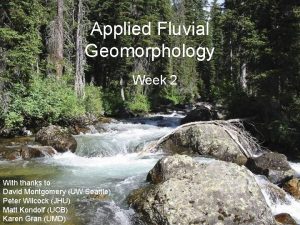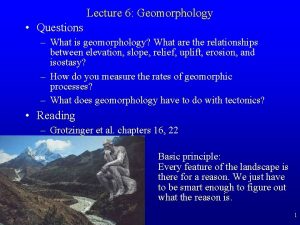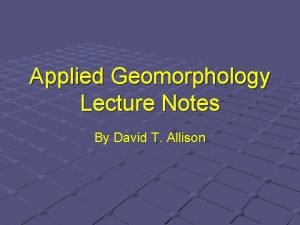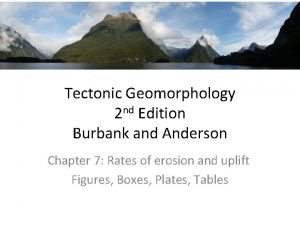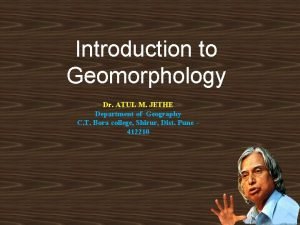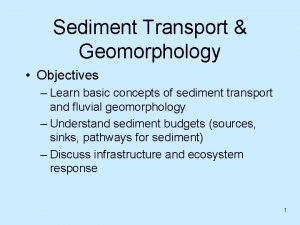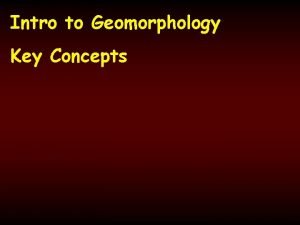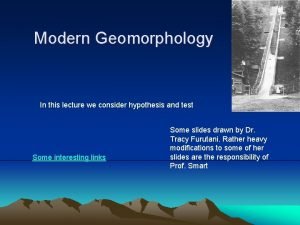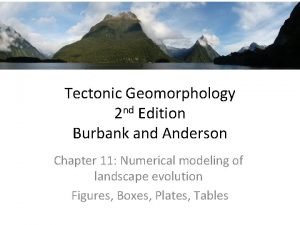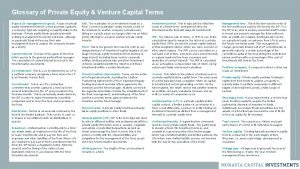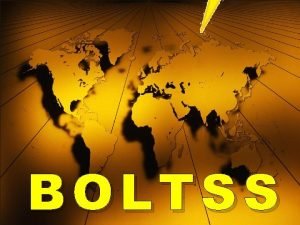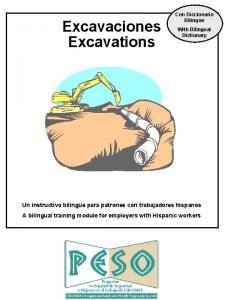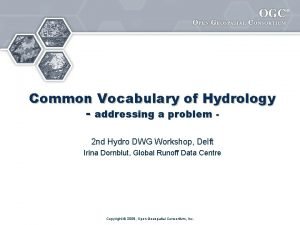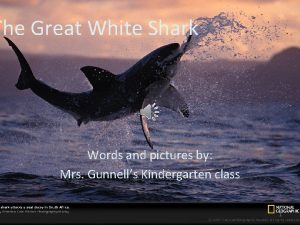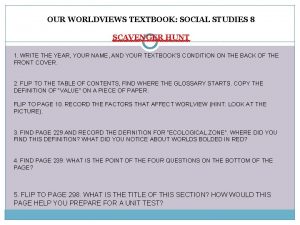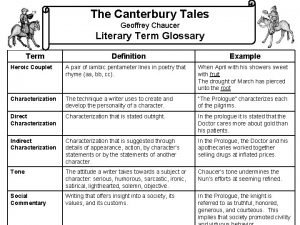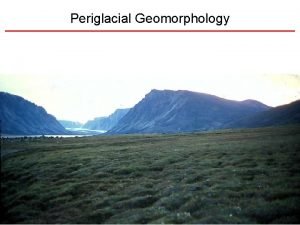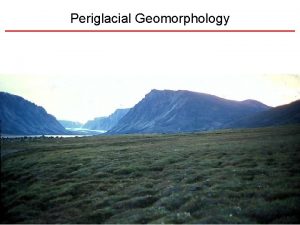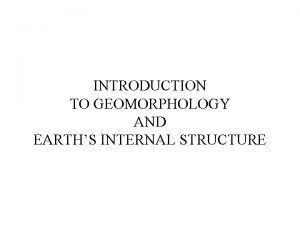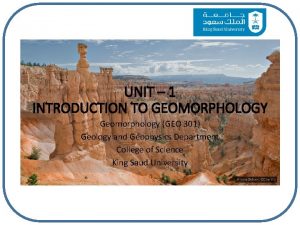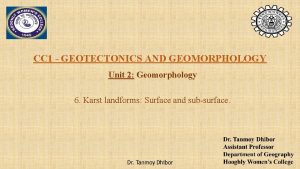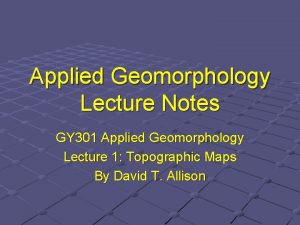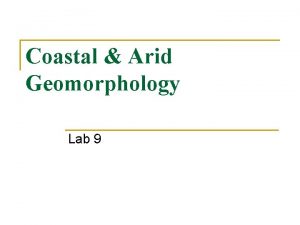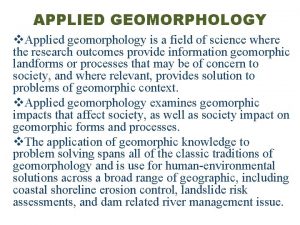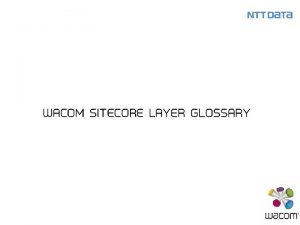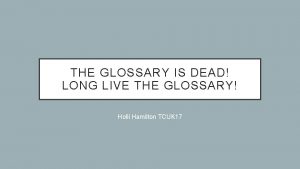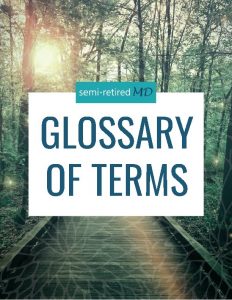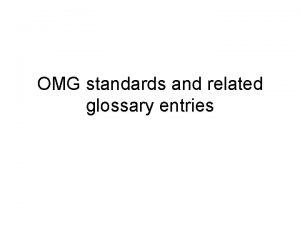Periglacial Geomorphology A Useful Glossary The periglacial environment






















- Slides: 22

Periglacial Geomorphology A Useful Glossary

The periglacial environment • Air temperature <-6°C • Albedo follows cycle – affects surface T • Snow cover drives albedo • Result = surface and subsurface temps!

Permafrost distribution • Continuous -5 to -10 °C Mean annual average temperature Discontinuous – In coastal Greenland • Sporadic – Mountains

Permafrost: soil at or below the freezing point of water 0 °C (32 °F) for 2 or more years. Permafrost o mean annual T o below 0 C • Surface changes are in “Active Layer” – thin soil layer of soil over the permafrost, seasonally thaws

Frost Heaving • Soils containing water that expands when frozen, moving the soil upward. • Large scale palsa formed by winter frost heave, then cut by summer meltwater

A chaotic pattern believe to be due to periglacial Frost Heave of the unconsolidated Bridgeton Fm, near Hammonton, NJ. Photo courtesy of. R. Kroll.

Periglacial - peripheral to glacier • Tundra & intense frost - often permafrost Permafrost underlies ~24% 0 f land, mostly northern Alaska, Canada, Russia, China U-shaped Valley Palsas Top 1 -2 meters is subject to seasonal thaw Palsa: low frost heaves containing frozen ice lenses. Here frost heaved peat hummocks Palsas in peat moss Tundra: biome where plant growth hindered by low temperatures and short growing seasons. Plants: dwarf shrubs, sedges and grasses, mosses, and lichens.

Ice Wedges • Cracks formed by a narrow piece of ice that extends downwards into the ground up to several meters. • Once temperatures reach -17 o. C or lower, the ice expands to form cracks in the surface known as ice wedges. Ice wedges connect to form ice wedge polygons.

Ice Wedge Casts Active layer ice melts in summer, water warms ice wedge in permafrost, hole fills with soil from active layer

An Ice Wedge cast near Hammonton, NJ. Photo courtesy of R. Kroll

Patterned Ground Surrounding Melt Lakes http: //nsidc. org/frozenground/how_fg_affects_land. html • As water freezes, it expands • Freezing of groundwater forces larger stones upward • Wet soils flow underneath larger stones, keeping them up. • Soils are water saturated, large rocks are not, wet soils freeze and expand, push larger stones away from the center Sorted nets

http: //www. ifa. hawaii. edu/~meech/a 740/2006/spring/papers/mangold_2004 b. pdf Patterned Ground on Mars • Figure 2. Different examples of highlatitude patterned ground on Mars. (C) 200 m wide polygons formed by networks of cracks • inside a crater MOC (type LT). MOC image E 0300299 (64. 7 N, 292. 9 W).

Frost Mounds: Pingoes Image: Charlie Paull © 2003 MBARI A pingo rises from the Arctic plain in far northern Canada, near Tuktoyaktuk, NWT. Open stage http: //gsc. nrcan. gc. ca/permafrost/index_e. php Pingos : water confined underground freezes, buckles the ground upward.

“At least some of the vast amount of water that carved Mars’ fluvial and flood morphologies is still present in the form of ground ice. One of the most intriguing forms of ground ice is the Pingo, a type of massive ice-cored mound found in periglacial and previously glacial terrains on Earth” Mars Pingoes

Thermokarst http: //ougseurope. org/rockon/surface/thermokarst. asp Characteristic landforms from thawing of ice-rich permafrost or the melting of massive ice blocks. It is characterized by an irregular topography, with irregular pits and depressions develop by thaw settlement

Solifluction Slow downslope movement of alternately dry and water saturated sediment

Gelifluction lobe on south slope of Låktatjåkka, 1400 m asl, 20050807 (Jan Boelhouwers) Gelifluction Skip 314 right to 318 left. http: //www. eld. geo. uu. se/SPG/pictures/P 8040004. JPG

High Latitude crater slope flow on Mars http: //www. sciencedirect. com/science/article/pii/S 0019103511005021 Fig. 7. (a) CTX image (B 01_010077_2520_XN_72 N 015 W) showing the crater 1 study areas as solid boxes. HIRISE coverage is shown as dotted boxes. (b) Sub frame of Hi. RISE image (PSP_010077_2520) showing widespread, non-sorted lobes at north-east facing wall. (c) Lobe features alongside a braided channeled gully. (d) Close up of lobe features; note the densely fractured surface on the treads. (e) Close up of stripes, white arrows indicate coarse bands. Image credit: NASA/JPL/MSSS and NASA/JPL/Uo. A.

Frost Wedging Thermal Expansion & contraction Frost scaling = spalling Polar regions: Strong Mechanical Weathering Very slow chemical weathering

Block Fields = Felsenmeer (CO Front Range) Frost Wedging, Spalling Frost Shattered Granite Bedrock

Rock Glaciers Rock Glacier angular rock debris usually frozen in interstitial ice Northwest Territories, Canada All known rock glaciers are derived either from glacial debris downvalley from an active or inactive glacier, or from avalanche debris, sliderock, or colluvium on a valley wall" Bloom, p. 319 Park Range, CO

Rock Glacier • Three types • Glacial: created by the recession of debris covered glaciers • Periglacial: continuous freezing occurring within a talus lobe • Landslide: does not require the presence of ice
 Applied fluvial geomorphology
Applied fluvial geomorphology Forces
Forces Applied geomorphology notes
Applied geomorphology notes Geomorphology
Geomorphology Application of geomorphology
Application of geomorphology Lane's balance
Lane's balance Dynamic equilibrium in geomorphology
Dynamic equilibrium in geomorphology Hypothesis in geomorphology
Hypothesis in geomorphology Tectonic
Tectonic Glossary icon
Glossary icon Private equity vs venture capital
Private equity vs venture capital Glossary of usage worksheet answers
Glossary of usage worksheet answers Who health promotion glossary
Who health promotion glossary Hotel revenue management glossary
Hotel revenue management glossary Boltss map
Boltss map Horizontal bracing
Horizontal bracing International glossary of hydrology
International glossary of hydrology Pictures
Pictures How photosynthesis takes place
How photosynthesis takes place Our worldview grade 8 textbook
Our worldview grade 8 textbook Ap spanish lit reading list
Ap spanish lit reading list Chaucer glossary
Chaucer glossary Pabalat na pahina
Pabalat na pahina
